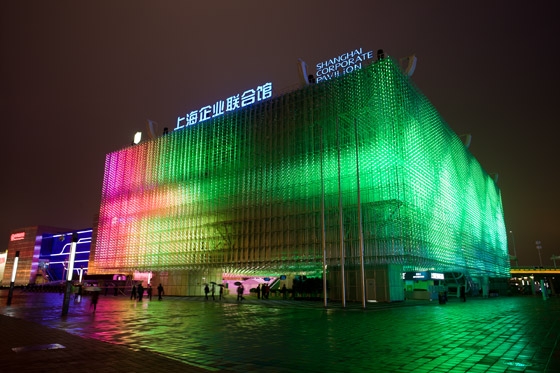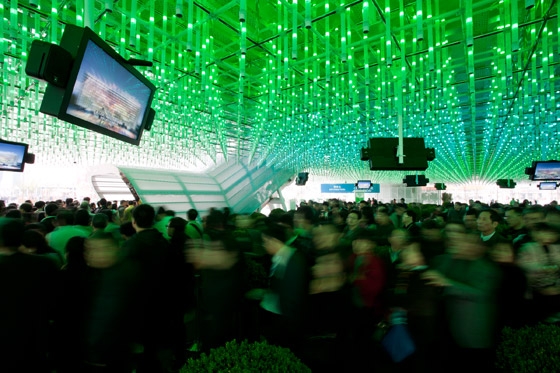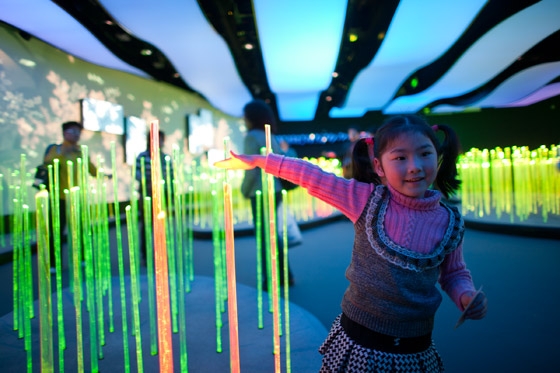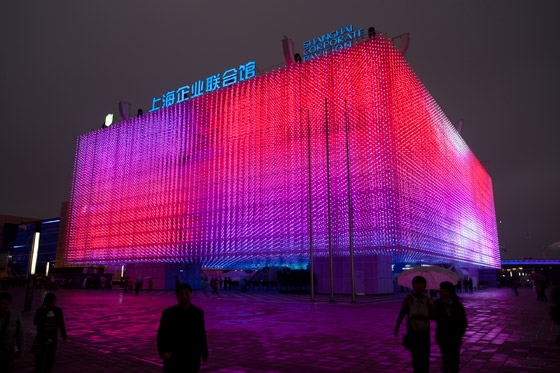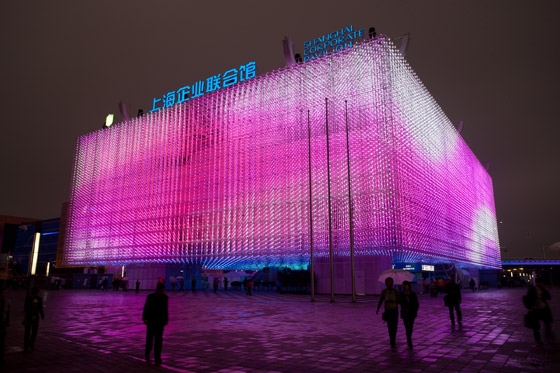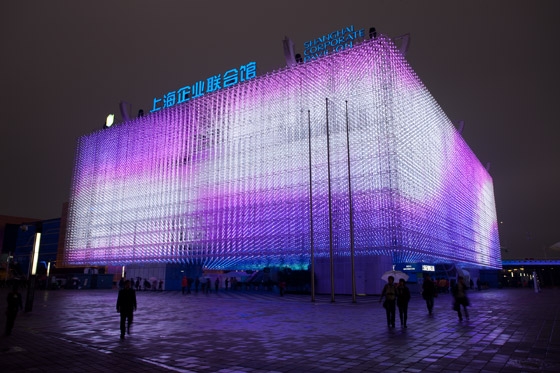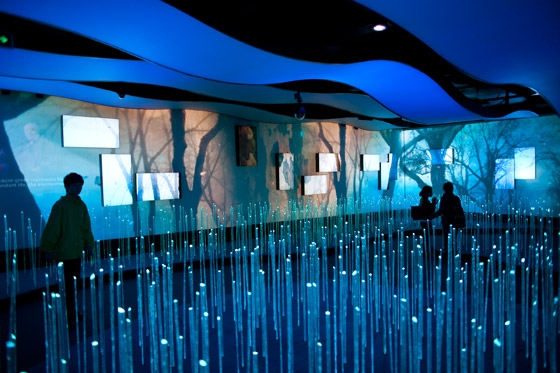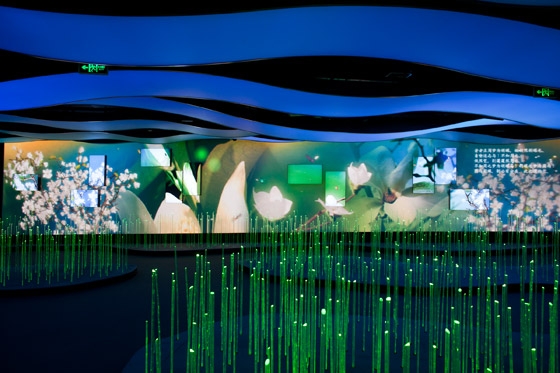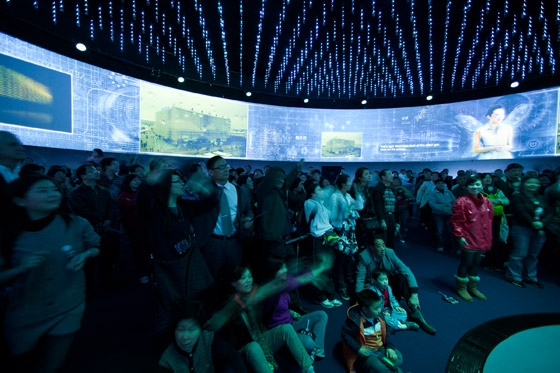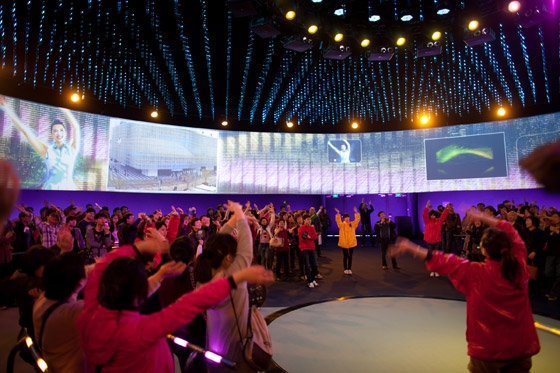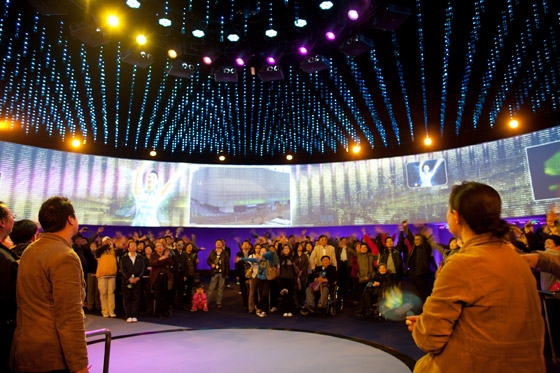Shanghai Corporate Pavilion Overview
• As part of the World Expo in Shanghai, the Shanghai Corporate Pavilion (SCP) commissioned New York City-based ESI Design to create a design that would express their dreams for Shanghai’s future, better life through growth, and their commitment to social and environmental responsibility.
• The Shanghai Expo runs from May 1 to October 31, 2010, features 200 pavilions, and is expecting more than 70 million visitors.
• The theme of the Shanghai Corporate Pavilion is “My City, Our Dreams.”
• Dubbed the “Dream Cube,” the Shanghai Corporate Pavilion is a 40,000 square-foot public experience that uses advanced multimedia and building technologies to demonstrate a powerful message — through collaboration, the people of Shanghai and the corporate community can create a better city with better lives for everyone.
• Inside the Dream Cube, visitors enter a magical world where stories of Shanghai’s past, present and future unfold through their participation – from crowd-sourced images of Shanghai uploaded by the public at the pavilion’s website, to a 360-degree theater experience where the visitors’ collective movements trigger changes to millions of LED lights on the Dream Cube’s façade.
• The Shanghai Corporate Pavilion is backed by some of the best creative and technological professionals from around the world including Edwin Schlossberg of ESI Design and Yung Ho Chang of Atelier FCJZ Architects (full list below).
• The environmentally friendly building is an impressive example of how technology can work with nature, transforming water and sunlight into energy that supports the building and its activities.
Inspiration
• ESI’s design for the pavilion was inspired in part by fourth-century Chinese philosopher Zhuangzi’s Butterfly Dream. In the story, Zhuangzi dreamt he was a butterfly flitting around, but suddenly woke up and didn't know if he was Zhuangzi who had dreamt he was a butterfly, or a butterfly dreaming he was Zhuangzi. “This is the transformation of things,” Zhuangzi famously writes.
• This idea of shifting perspectives and the theme of transformation became central pillars of the design.
• During the Dream Cube experience, virtual butterflies become the symbols of people’s dreams for Shanghai’s future.
Inside the Dream Cube
• ESI’s design showcases the dreams of Shanghai’s community through an immersive interactive experience that enables collective participation, collaboration and action.
• The 20-minute visitor experience features stunning visual and audio effects and is divided into four areas: a queuing area, the Ascent to Dreams escalator, the Dreamer’s Path and the Dream Cube Control Room, an immersive, interactive 360-degree theatre experience where the visitors’ collective movements trigger changes to millions of LED lights on the Dream Cube’s façade.
• The amazing journey starts as visitors queue beneath the massive, yet ethereal structure, where thousands of LED rods pulse with light. From the queue, visitors ascend on an escalator, surrounded by bluish light and soft music, into the heart of the Dream Cube. There, they stroll along the “Dreamer’s Path,” a visual story of the city of Shanghai through time – from a small rural village to a vibrant mega-metropolis. Along the path, interactive areas fill with flying butterflies, changing seasons, crowd-sourced images of city life, sculptural lighting and surprise video “portals” that respond to visitor interaction. The path ultimately leads visitors into a massive circular theater — the Dream Cube Control Room — where they gather to participate in a 360-degree interactive video experience narrated by the famous actress and director Xu Jinglei, who plays “Professor Butterfly” in the Dream Cube story. The giant screen immerses the audience in the sights and sounds of Shanghai through stunning visual flyovers and special effects, while Professor Butterfly invites them to reflect on the challenges and opportunities facing Shanghai. She praises the strength of Shanghai’s citizens and encourages them to work together to create a better city for all. In the final climactic moments, Professor Butterfly reveals live-feed images of the exterior façade, as she rallies the crowd to wave their arms high in the air. In lively response, the Dream Cube’s exterior pulses with color in time with their collective actions, sweeping them up in the emotional and transformative power of collaboration.
Designing With the City
• ESI invited the people of Shanghai to contribute photos via the Web that would become a part of a collaborative composition of the Dream Cube.
• The Shanghai Corporate Pavilion website launched in May 2009 to invite people from around the world to contribute photographs to fun assignments such as “Celebrate Shanghai’s Youth” and “Make a Portrait.”
• More than 20,000 photographs were contributed online to the “People’s Archive,” which was orchestrated by famed curators, HS Liu and Karen Smith.
• Along the Deamer’s Path, visitors have the opportunity to encounter images that they might have contributed to the experience through the Dream Cube’s website. The design demonstrates that, by working together, we can create a better city, better life, and better world.
Architectural Integration
• Rather than being designed from the outside in, like many other architecture-driven pavilions, the Dream Cube was designed from the visitor experience outwards, creating stunning, seamless synergies between the “exhibit” and “architectural” experiences. Edwin Schlossberg of ESI Design and architect Yung Ho Chang of Atelier FCJZ collaborated from the very beginning of the project, working hand-in-hand to create this innovative integrated experience.
• The interior spaces of the pavilion are shaped as a series of free-flowing organic forms, unencumbered by traditional walls. The forms are embedded within a dense, infrastructural network of recycled rods that house millions of LED lights, which change the appearance of the building in response to visitor interaction.
Sustainable Building Design
• Solar Energy: The Pavilion features a solar thermal system that collects solar energy to produce hot water and generate electricity that powers the Pavilion.
• Recycled Materials: China produces nearly 140 million tons of plastic waste every year, with only 25 percent ever reclaimed or recycled. The external facade of the Shanghai Corporate Pavilion is comprised of polycarbonate transparent plastic tubes made from recycled materials filled with LEDs. After the Expo, the plastic tubes can be recycled to reduce the environmental impact of the pavilion.
• Water: Rainwater will be collected, recycled and used for the building’s unique misting system that keeps visitors cool and helps create the ethereal dream-like effect of the building’s exterior.
Fun Facts
• The Dream Cube is comprised of a 65 km long grid made from plastic tubes, each spaced half a meter apart with LEDs every ten inches, creating an incredibly unique 3D display surface.
• Twenty-five 40-foot shipping containers came across the ocean from Germany to Shanghai with all of the technology needed to fill the Dream Cube.
• The Dream Cube is 63 meters long, 48 meters wide, and 23 meters tall. Thousands of miles of cable are woven through the Dream Cube to power the experience.
• More than 20,000 crowd-sourced images were contributed to the People’s Archive via the Dream Cube website.
